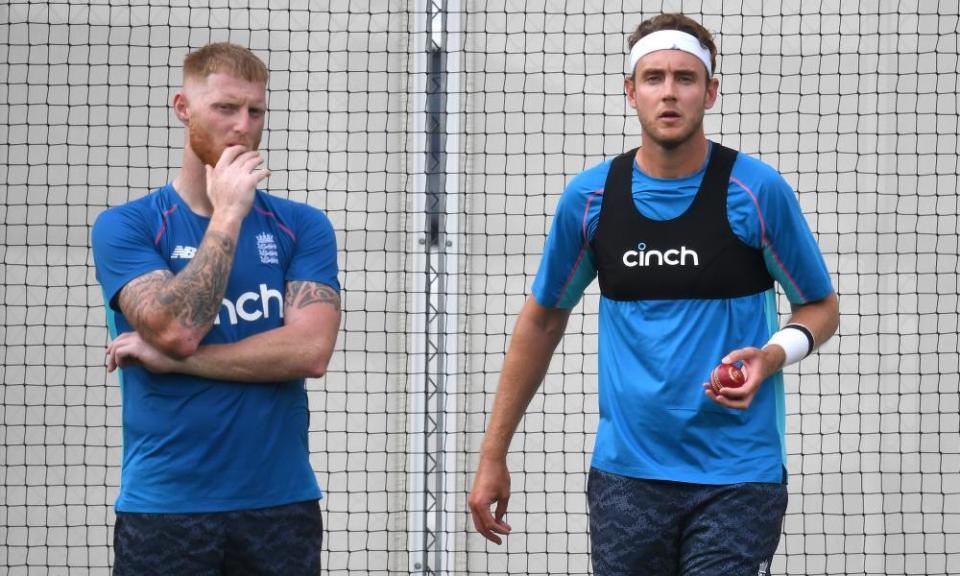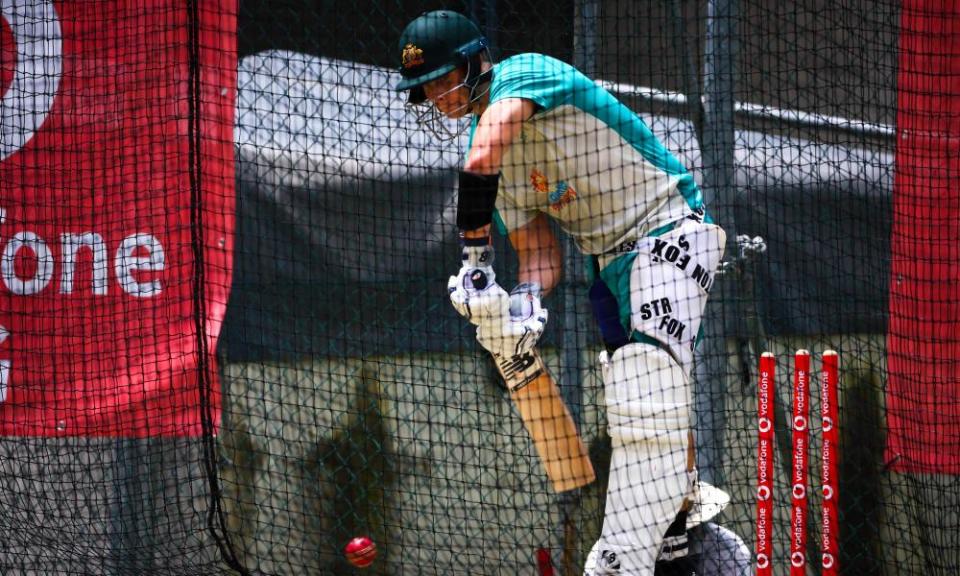An Ashes series like no other: let the hostilities, or even the respect, begin
It is the Ashes series that flirted with postponement but, barring unexpected late hiccups or early rain, the world’s highest ranked bowler and batsman, Pat Cummins and Joe Root, will lead their teams out to a packed Gabba on Wednesday morning to begin the latest chapter in Test cricket’s most storied rivalry.
“There’s Test cricket and then there’s Ashes cricket,” Root proclaimed, among the wave of pre-series interviews in which he and Cummins, the nascent home captain, have featured during a buildup period of little actual cricket. While Australia’s recent T20 World Cup victory overseas did not penetrate the zeitgeist, their public have woken up for the old enemy’s arrival and the longest format’s return after a year of remarkable patience. Both captains have smiled in the main, Root comfortably engaging with the notion that a tenure of 56 Tests and an English record 27 wins will now be defined by the next six weeks.
Related: How important is the first ball of an Ashes series? Just ask Steve Harmison | Tanya Aldred
Six sublime centuries and 1,455 runs this year mean the 30‑year‑old could seldom have wished for better personal form attempting this moonshot in a country of past demons. Come the fifth Test in the 2013-14 whitewash Root was dropped the one and only time as Mitchell Johnson vaporised a whole era and four years later he spent the last rites of his side’s schooling laid out in the SCG dressing room with an awful gastro bug. At least his stomach was spared the big hands on the podium that read 4-0.
Those results meant that when England named their squad in October there was little optimism to be found among followers, even if India did come from behind to triumph on Australian soil this year and broke a 32-year unbeaten record at the Gabba in the process. Perhaps this scepticism remains the case for many. Yet a succession of events has seemingly nudged England’s prospects up a touch, be it Ben Stokes announcing a return, the La Niña weather system that could assist Root’s predominantly fast‑medium attack when playing in the east, or the Tim Paine “sexting” scandal that forced Australia into a late change of captain.
Confirmation on Monday that England will not face the bouncier clay soil of Perth in the fifth Test but rather an alternative venue and a possible second pink-ball day-night match, adds to this sense of a clear underdog getting further breaks. More will be needed, not least for a side described by the returning Gabba crowd favourite Stuart Broad as “the worst prepared in the modern era” in terms of their warm-up cricket.

If there is one lament shared on both sides of the Ashes divide it is that Jofra Archer is absent with an elbow injury. There will be no repeat of the searing spells witnessed during the drawn 2019 series in which Australia overcame their Stokes-inflicted Headingley meltdown and retained the urn they again defend.
Nevertheless Root should be able to unleash Mark Wood’s 90mph-plus pace for the first time in Australia, albeit selectively to maximise his impact. Having Stokes back is arguably the greatest plus: Root looked lost without the talismanic vice-captain alongside him four years ago to an extent that Ricky Ponting dubbed him a “little boy” and a nerve was struck.
This void was created by the Bristol street fight eight weeks before the tour and something on which Australia’s players then capitalised at the Gabba. Details of a “headbutt” by Jonny Bairstow on Cameron Bancroft in a Perth bar upon England’s arrival were teased over the stump mic in Brisbane but also kept deliberately vague thereafter to generate a distracting media storm.
Australia (confirmed): Marcus Harris, David Warner, Marnus Labuschagne, Steve Smith, Travis Head, Cameron Green, Alex Carey (wk), Pat Cummins (c), Mitchell Starc, Nathan Lyon, Josh Hazlewood.
England (possible): Rory Burns, Haseeb Hameed, Dawid Malan, Joe Root (c), Ben Stokes, Ollie Pope, Jos Buttler (wk), Chris Woakes, Ollie Robinson, Mark Wood, Stuart Broad.
Nathan Lyon also spoke of “ending careers” before that 10‑wicket victory. But, in this post-sandpaper era, and with both the Paine affair and the Yorkshire racism scandal still raw, the phoney war has been practically non‑existent so far. Instead we have two sides who should, with luck, look to let performances do the talking in the image of their respective captains (even if shared hotels all tour could yet lead to familiarity breeding a degree of contempt).
Root versus Cummins certainly looks the most enticing of encounters, a rare chance to see two Ashes captains in direct contest on the field. Cummins has had Root’s number seven times in their 10 previous encounters by relentlessly targeting a fourth‑stump line with the odd full straight one. But then never before has the Yorkshireman’s bat looked so thick and glowing as it has done in 2021.
Of course it may well be that Steve Smith follows another year starved of the format that consumes his world and now unloads his latest landslide of runs to settle matters. Like the virus that has stalked the logistics of this tour for months, thoughts of outright elimination here are futile. But suppression of the vice-captain’s output, such as India achieved when keeping him to a mortal average of 44, and things could open up for the tourists.

Not that Australia are a one-man batting lineup, a charge levelled at England all year given Root has scored 976 more runs than the next best, Rory Burns. David Warner, with confidence back after the T20 World Cup win, is a different beast at home from the one emasculated by Broad and the Dukes ball two years ago, while the Smith-acolyte Marnus Labuschagne also averages 72 in Australia.
The attack that England will initially deploy was a source of speculation two days out. While Australia boldly named their XI on Sunday, and now have a fourth seamer in the hulking all-rounder Cameron Green, Root and Chris Silverwood were still staring at the pitch and forecast trying to decide theirs. And, though Stokes now offers a route into the side for Jack Leach’s left-arm spin, a desire not to overburden the all-rounder after four months out, and a possible rain-affected match, may yet lead to a five-man pace attack.
Either way, Jimmy Anderson, 39 and needing further preparation time, is to be kept on ice until the more swing-friendly pink ball second Test next week. Broad, Ollie Robinson and Chris Woakes (if not two plus Leach) will be trying to emulate the Indian attack that triumphed in Australia 12 months ago, with Wood picked to transcend the older ball and bounce out the lower order. When it is their time to bat, all four know they will get the same treatment however.
Related: Plug pulled on Perth Test as contenders jostle to host Ashes series finale
Australia’s attack, one in which the immaculate Josh Hazlewood and the mercurial Mitchell Starc are down to share the new ball initially, will be able to charge all series with baying crowds fully behind them. Where once Ashes newcomers such as Haseeb Hameed and Ollie Pope might draw comfort from a strong English presence in the stands – so, too, the bowlers when the Kookaburra ball goes flat – they will have only a smattering of expat support because of the pandemic.
A Queensland border that will stay as impenetrable as its State of Origin team’s front row until next week also means swaths of media personnel from both countries will start the series watching from afar. Fingers are now crossed that the South Australian government does not boomerang its recent reopening and prevent those based in Victoria and New South Wales from attending the second Test in Adelaide.
Root acknowledged how unusual this all was 48 hours before the all-important toss. But when the first ball comes fizzing down at Australia’s traditional Ashes stronghold, familiar feelings should come flooding back. Will a familiar result follow? As has always been the case since the two countries first met on a cricket field in 1877, the beauty is in finding out.

 Yahoo Sport
Yahoo Sport 





































